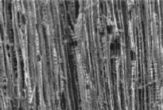Presto! Instant Petrified Wood Created in Lab

Achieving what would take millions of years in only a few days, scientists have drastically sped up the process of petrifying wood.
Yongsoon Shin and his colleagues at the Pacific Northwest National Laboratory have recreated, under laboratory conditions, the conversion of wood into a ceramic, the very process of petrification.
The lab process "is pretty much same as petrification in nature, where the products are even denser -- organic components are self-degrading -- due to the long time process," Shin explained.
The results are published in the current issue of the journal Advanced Materials.
For their experiment, Shin and his colleagues used pine and poplar boards from a local lumber store, cutting the wood into small cubic samples. Once the samples were cleaned and cut, they were soaked in hydrochloric acid for two days and then soaked in silica solution for another two days. After the wood had been air-dried, the pieces were placed into a furnace filled with argon gas and steadily heated to 1400 degrees Celsius, where the samples baked for two hours.
Finally, the samples were cooled to room temperature in an atmosphere of argon.
The finished product was silicon carbide, a ceramic version of the wood, which was petrified as if it had been trapped in sediment for millions of years. The material "replicates exactly the wood architecture," Shin said.
Sign up for the Live Science daily newsletter now
Get the world’s most fascinating discoveries delivered straight to your inbox.
This type of petrification, called silicification, is one of the best known and is the one that is responsible for wood appearing to have turned to stone. In silicification, the decay process first needs to be inhibited. This usually happens when wood is covered by sediment - volcanic ash or lava flow, for example. Solutions of silica that are found in groundwater infiltrate the wood and its individual plant cells.
The silica penetrates the cell walls and dissolves it, fuses with the carbon in cellulose to form silicon carbide - a ceramic - and maintains the physical structure of the wood. Since this process could take millions of years, what is left is a fossil record that can give scientists valuable information about the era when the wood was a tree.
Shin proposes that because of the petrified wood's porosity and high surface area -- one cubic centimeter has the surface area of a football field -- it could be particularly useful for filtering or absorbing pollutants or other chemicals.
Wilkes Land crater: The giant hole in East Antarctica's gravitational field likely caused by a meteorite
Get a closer look at wildlife for less: This huge $60 saving on the Bushnell 10x42mm Trophy XLT binoculars — now down to their lowest-ever price at Adorama
Acer Aspire Vero 16 review: Admirably eco-conscious










